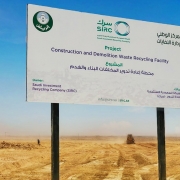Recycled Construction Waste in Europe
The European construction industry is working towards producing high-quality materials from recycled waste, enhancing the sector’s sustainability and reducing its environmental impact.
In the southern Belgian province of Namur, concrete and bricks from demolished buildings are being turned into eco-friendly road surfaces.
A local company recycles 180,000 tons of concrete, tarmac, sand and mixed soils at its two plants, much of which is deployed to regenerate the region’s highways or to build new ones. Richard Marchand, director for production and transport at Hublet, adds that they apply a double quality check, with an interior and external quality control on the recycled concrete.
Initial skepticism in the industry fueled by concern about poor-quality recycled products has given way to greater confidence in techniques and standards for reprocessing of construction and demolition waste (CDW), and this, in turn, has encouraged innovations in the sector as entrepreneurs seek to reduce costs without compromising on quality or environmental standards.
CDW is the largest waste stream in the EU by volume, with about 850 million tons produced annually. Previously, most of this ended up being dumped. But today, scrap metals can be recycled almost endlessly; asphalt can be crushed and reconstituted; clean and untreated wood is turned into lumber and chipboard; and both gypsum, used to build walls, and glass from windows and tiles can be refashioned into a multitude of new products.
Belgium is among the leading European countries for the recycling of CDW. Germany is the first EU country by volume, with about 68 million tons recycled every year, but proportionally the Netherlands is the best, with about 90 percent of material recycled. However, only just over half of all CDW in the EU is recycled, which means that member states have major work ahead of them to meet the target of 70 percent recycled and reused by 2020, as outlined in the 2008 Waste Framework Directive. Environmental organizations believe it is an important target, with Legambiente, an Italian NGO, estimating that its achievement could lead to the closure of 100 quarries in Italy.
To add momentum to this process, in 2016 the European Commission published a CDW Management Protocol, whose goal is to improve waste identification, source separation and collection, and waste processing. From the industry perspective, it is essential to make sure that there are no hazardous substances in material recovered from a demolition site – such as asbestos, leaded paint and polychlorinated biphenyls – that may affect health, environmental or building quality standards.
Promotion of recycled aggregates
“We encourage the promotion of recycled aggregates where economically, environmentally and technically feasible, respecting the given technical standard,” says Alev Somer from the European Aggregates Association (UEPG). Construction engineers often prefer to trust primary raw materials, so “it’s essential that demolition waste is suitable and can meet the same standard as the primary material.”
Brussels has launched ten pilot building sites, involving a partnership of local government and building companies. The scheme encourages constructors to separate metal, woods, gypsum, concrete, and hazardous substances such as empty silicone sealant guns before sending to the recycling centers. Just one example underlines the potential of CDW: Around 120 square meters of tiles from a demolished building was reused on the same site for a new construction, insulation material was recycled for a new roof, and wood and glass were used to build a greenhouse at a farm on the outskirts of Brussels.
Finally, Somer points out that “recycled aggregates can only cover 12 to 20 percent of the total demand for aggregates for the foreseeable future.” Eighty percent of the demand still would need to be supplied by natural primary aggregates, even in countries where recycling rates reach near 100 percent.
Therefore, for the aggregates industry, the only way to reduce waste in the future is to encourage the application of an optimal construction design philosophy to have built-in adaptability and minimal end-of-life demolition.
www.bresaer.eu
Source: Margherita Sforza/Youris.com
Photo: Jenny Marvin/AlphaGalileo
(GR 22019, Page 32)









